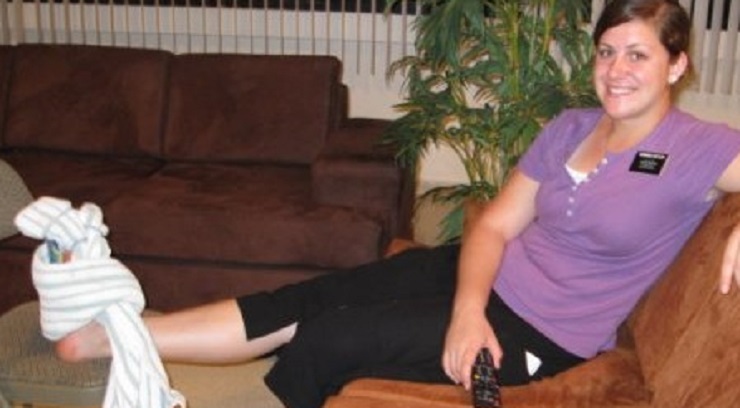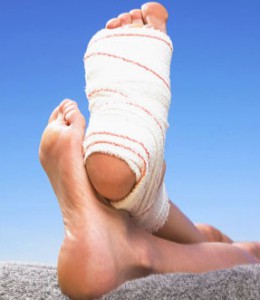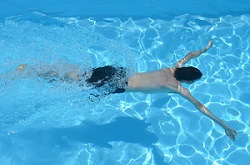
Using the RICE method for heel pain focuses on initial self-care following the onset of plantar fasciitis pain. Across the internet, many websites recommend RICE as an initial step in foot restoration. The method’s acronym stands for the four concepts of Rest, Ice, Compression, and Elevation.
These four concepts may be particularly important during the early phase of recovery from the problem or injury that caused your plantar fasciitis pain to flare up. Implementing these four concepts on a daily basis should reduce the stress on your plantar fascia, at least to some degree, allowing your fascia to heal quicker.
Understanding the Four Concepts
Let me break down these four concepts. Simply put:
- Rest (R) – This does not mean you have to lie down or even sit all the time. It refers to reducing your previous activity level. In other words, whatever level of activity you were at when your plantar fasciitis flared up, cut back some. For example, walk a little more and run a little less or sit a little more and stand a little less. The degree to which you change your activity will be somewhat dependent on the severity of the pain.
- Ice (I) – Use ice to reduce the inflammation and/or swelling in your feet. Ice packs work great for this. Be sure to wrap the ice or ice pack in a towel or protective sleeve to prevent the ice from burning your feet. Alternatively, you could freeze a plastic bottle full of water and roll your foot over the frozen bottle or you could freeze water in a small paper cup, remove the ice from the cup and rub the ice over the sore area for 5-10 minutes.

- Compression (C) – During the initial phases of recovery it is a good idea to add support to your foot. The added pressure can be applied with a wrap, such as a simple Ace bandage, or special socks/hose, such as TED hose. Shoes with appropriately strong support are a must at this stage of recovery.
- Elevation (E) – Elevating your foot, when possible, can also be helpful, just as it is whenever you have any type of foot or leg injury. Elevation helps reduce and eliminate swelling. One good way to do this is to lie on your back and elevate your foot onto a chair for 5-10 minutes.
Note that the length of time to execute each step as well as the number of times to perform the RICE process each day is not set in stone. Some sites recommend 10 minutes or 15 minutes of icing and elevation, others a bit less. Likewise, some discuss 2-3 repetitions of RICE each day while others suggest up to 8 repetitions.
You need to decide what you can do. The key is to do something!
Reducing Your Activity Levels
In addition to utilizing these concepts, reducing your weight-bearing foot activity on a daily basis is also critically important. In other words, change the amount of time you spend on your feet, if at all possible. Counter this potential reduction in exercise by adding some low-impact activities. Cycling and swimming are two good options that do not aggravate the plantar fascia tissue.
Note that activities like running and jumping are significantly aided by a healthy plantar fascia tissue. The fascia helps your leg, ankle, and foot muscles to function well and to work efficiently. So, if you are a runner, reduce the amount of running you do each day immediately.
Additional Therapy 
While conventional thought on the healing of plantar fasciitis continues to recommend the RICE concept, there are additional home-therapy ideas that can and should be considered in conjunction with RICE. Exercises, massage, and medication are three of these helpful ideas. Consider these early on in your rehabilitation process.
Will RICE Help You?
There is some dispute as to whether or not the RICE method can be effective in reducing heel pain. The dispute is based on relatively new studies indicating that plantar fasciitis has little to do with inflammation.
Rather than inflammation, these studies indicate that plantar fasciitis is a degenerative disorder. In other words, the plantar fascia is degenerating, causing micro-tears in the collagen fibers of the fascia. If this is true, taking steps aimed at reducing inflammation would prove to be pointless.
One of the best explanations, which incorporates both initial inflammation and then collagen restoration, can be found in the article entitled, What is the difference between plantar fasciitis and plantar fasciosis?. Based on the idea that there is an initial phase, immediately following injury, when inflammation does occur, it appears that RICE will probably still be an effective initial method of self-care.
Your Thoughts
Have any of you utilized this process to help reduce plantar fasciitis pain? I would like to hear from you. Did you find the process effective? Was one step more important than the others in reducing your pain? Please respond using the comment box below.

Had it in both feet. got rid of latest one after my podiatrist gave me a shot of hydrocortisone. He also gave me an exercize. Put your foot at a 45 deg angle to a wall, toes up, and lean foreward. Stretches the ligaments. Helps for a while.
I hope you don’t mean you had it in both feet at the same time! That would be horrible, for sure. The exercise you mention appears to be a slight variation from a very common type of stretch. Getting the fascia, achilles tendon, and calf muscles to be more flexible and stretched out can alleviate a lot of potential pain.
Thanks for sharing a little of your story, Alan.
Well you learn something new everyday, while I knew you had to put ice, certainly had no idea there was the term RICE involved :), thanks for sharing …may come handy for tomorrow’s cross-fit session lol
Yes, ICE is part of RICE, but just the “I”. I’ve found references to the RICE process on many doctor and medical sites, let alone personal ones. It’s a process that can help avoid a number of foot-related issues. In fact, the process is important for more than just the feet. Those four steps are good for any type of minor limb issue.
Hope it helps the cross-fit sessions. Thanks for sharing.
Hi Allyn, I have suffered from plantar fasciitis in the past and used all of the concepts in the RICE method you mention above to get to the point where my feet were no longer hurting. My condition was originally caused due to a walking holiday in the French Alps, over stretching the plantar. Now I use custom made orthotics inserted in my shoes to support my feet. A local podiatrist (I am in the UK) supplied these after taking plaster casts of my feet and they work very well. No pain now unless I stand in one place for a long time, but I can walk and run no problem.
Cheers
Neil
Ah, Neil, my foot started hurting as I read your response. The walk in the Alps would be magnificent, but you probably over-did it just as I tend to do when I go on holiday. I’m glad to hear that the pain is gone (mainly).
Orthotics is another whole area that I’ll be getting to as I continue to build my site. Thanks for sharing your thoughts.
Great article Allyn. I don’t have heel or foot pain, but I did just recently pull a hamstring while doing sprints. I used the same exact RICE method to help recover from it.
I did add Aspirin and self-massage while in a hot bath.
It worked I was back and jogging in a couple of days.
Phil
Good to hear from you, Phil. The aspirin and massage go along very well with the RICE methodology. Thanks for mentioning them.
I wish I would have known these methods years ago when I kept pulling my hamstrings playing church league softball!